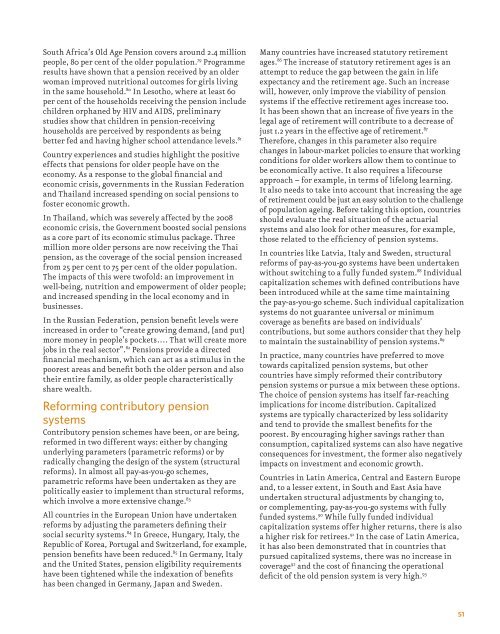Ageing in the Twenty-First Century: - HelpAge International
Ageing in the Twenty-First Century: - HelpAge International
Ageing in the Twenty-First Century: - HelpAge International
Create successful ePaper yourself
Turn your PDF publications into a flip-book with our unique Google optimized e-Paper software.
South Africa’s Old Age Pension covers around 2.4 million<br />
people, 80 per cent of <strong>the</strong> older population. 79 Programme<br />
results have shown that a pension received by an older<br />
woman improved nutritional outcomes for girls liv<strong>in</strong>g<br />
<strong>in</strong> <strong>the</strong> same household. 80 In Lesotho, where at least 60<br />
per cent of <strong>the</strong> households receiv<strong>in</strong>g <strong>the</strong> pension <strong>in</strong>clude<br />
children orphaned by HIV and AIDS, prelim<strong>in</strong>ary<br />
studies show that children <strong>in</strong> pension-receiv<strong>in</strong>g<br />
households are perceived by respondents as be<strong>in</strong>g<br />
better fed and hav<strong>in</strong>g higher school attendance levels. 81<br />
Country experiences and studies highlight <strong>the</strong> positive<br />
effects that pensions for older people have on <strong>the</strong><br />
economy. As a response to <strong>the</strong> global f<strong>in</strong>ancial and<br />
economic crisis, governments <strong>in</strong> <strong>the</strong> Russian Federation<br />
and Thailand <strong>in</strong>creased spend<strong>in</strong>g on social pensions to<br />
foster economic growth.<br />
In Thailand, which was severely affected by <strong>the</strong> 2008<br />
economic crisis, <strong>the</strong> Government boosted social pensions<br />
as a core part of its economic stimulus package. Three<br />
million more older persons are now receiv<strong>in</strong>g <strong>the</strong> Thai<br />
pension, as <strong>the</strong> coverage of <strong>the</strong> social pension <strong>in</strong>creased<br />
from 25 per cent to 75 per cent of <strong>the</strong> older population.<br />
The impacts of this were twofold: an improvement <strong>in</strong><br />
well-be<strong>in</strong>g, nutrition and empowerment of older people;<br />
and <strong>in</strong>creased spend<strong>in</strong>g <strong>in</strong> <strong>the</strong> local economy and <strong>in</strong><br />
bus<strong>in</strong>esses.<br />
In <strong>the</strong> Russian Federation, pension benefit levels were<br />
<strong>in</strong>creased <strong>in</strong> order to “create grow<strong>in</strong>g demand, [and put]<br />
more money <strong>in</strong> people’s pockets…. That will create more<br />
jobs <strong>in</strong> <strong>the</strong> real sector”. 82 Pensions provide a directed<br />
f<strong>in</strong>ancial mechanism, which can act as a stimulus <strong>in</strong> <strong>the</strong><br />
poorest areas and benefit both <strong>the</strong> older person and also<br />
<strong>the</strong>ir entire family, as older people characteristically<br />
share wealth.<br />
Reform<strong>in</strong>g contributory pension<br />
systems<br />
Contributory pension schemes have been, or are be<strong>in</strong>g,<br />
reformed <strong>in</strong> two different ways: ei<strong>the</strong>r by chang<strong>in</strong>g<br />
underly<strong>in</strong>g parameters (parametric reforms) or by<br />
radically chang<strong>in</strong>g <strong>the</strong> design of <strong>the</strong> system (structural<br />
reforms). In almost all pay-as-you-go schemes,<br />
parametric reforms have been undertaken as <strong>the</strong>y are<br />
politically easier to implement than structural reforms,<br />
which <strong>in</strong>volve a more extensive change. 83<br />
All countries <strong>in</strong> <strong>the</strong> European Union have undertaken<br />
reforms by adjust<strong>in</strong>g <strong>the</strong> parameters def<strong>in</strong><strong>in</strong>g <strong>the</strong>ir<br />
social security systems. 84 In Greece, Hungary, Italy, <strong>the</strong><br />
Republic of Korea, Portugal and Switzerland, for example,<br />
pension benefits have been reduced. 85 In Germany, Italy<br />
and <strong>the</strong> United States, pension eligibility requirements<br />
have been tightened while <strong>the</strong> <strong>in</strong>dexation of benefits<br />
has been changed <strong>in</strong> Germany, Japan and Sweden.<br />
Many countries have <strong>in</strong>creased statutory retirement<br />
ages. 86 The <strong>in</strong>crease of statutory retirement ages is an<br />
attempt to reduce <strong>the</strong> gap between <strong>the</strong> ga<strong>in</strong> <strong>in</strong> life<br />
expectancy and <strong>the</strong> retirement age. Such an <strong>in</strong>crease<br />
will, however, only improve <strong>the</strong> viability of pension<br />
systems if <strong>the</strong> effective retirement ages <strong>in</strong>crease too.<br />
It has been shown that an <strong>in</strong>crease of five years <strong>in</strong> <strong>the</strong><br />
legal age of retirement will contribute to a decrease of<br />
just 1.2 years <strong>in</strong> <strong>the</strong> effective age of retirement. 87<br />
Therefore, changes <strong>in</strong> this parameter also require<br />
changes <strong>in</strong> labour-market policies to ensure that work<strong>in</strong>g<br />
conditions for older workers allow <strong>the</strong>m to cont<strong>in</strong>ue to<br />
be economically active. It also requires a lifecourse<br />
approach – for example, <strong>in</strong> terms of lifelong learn<strong>in</strong>g.<br />
It also needs to take <strong>in</strong>to account that <strong>in</strong>creas<strong>in</strong>g <strong>the</strong> age<br />
of retirement could be just an easy solution to <strong>the</strong> challenge<br />
of population age<strong>in</strong>g. Before tak<strong>in</strong>g this option, countries<br />
should evaluate <strong>the</strong> real situation of <strong>the</strong> actuarial<br />
systems and also look for o<strong>the</strong>r measures, for example,<br />
those related to <strong>the</strong> efficiency of pension systems.<br />
In countries like Latvia, Italy and Sweden, structural<br />
reforms of pay-as-you-go systems have been undertaken<br />
without switch<strong>in</strong>g to a fully funded system. 88 Individual<br />
capitalization schemes with def<strong>in</strong>ed contributions have<br />
been <strong>in</strong>troduced while at <strong>the</strong> same time ma<strong>in</strong>ta<strong>in</strong><strong>in</strong>g<br />
<strong>the</strong> pay-as-you-go scheme. Such <strong>in</strong>dividual capitalization<br />
systems do not guarantee universal or m<strong>in</strong>imum<br />
coverage as benefits are based on <strong>in</strong>dividuals’<br />
contributions, but some authors consider that <strong>the</strong>y help<br />
to ma<strong>in</strong>ta<strong>in</strong> <strong>the</strong> susta<strong>in</strong>ability of pension systems. 89<br />
In practice, many countries have preferred to move<br />
towards capitalized pension systems, but o<strong>the</strong>r<br />
countries have simply reformed <strong>the</strong>ir contributory<br />
pension systems or pursue a mix between <strong>the</strong>se options.<br />
The choice of pension systems has itself far-reach<strong>in</strong>g<br />
implications for <strong>in</strong>come distribution. Capitalized<br />
systems are typically characterized by less solidarity<br />
and tend to provide <strong>the</strong> smallest benefits for <strong>the</strong><br />
poorest. By encourag<strong>in</strong>g higher sav<strong>in</strong>gs ra<strong>the</strong>r than<br />
consumption, capitalized systems can also have negative<br />
consequences for <strong>in</strong>vestment, <strong>the</strong> former also negatively<br />
impacts on <strong>in</strong>vestment and economic growth.<br />
Countries <strong>in</strong> Lat<strong>in</strong> America, Central and Eastern Europe<br />
and, to a lesser extent, <strong>in</strong> South and East Asia have<br />
undertaken structural adjustments by chang<strong>in</strong>g to,<br />
or complement<strong>in</strong>g, pay-as-you-go systems with fully<br />
funded systems. 90 While fully funded <strong>in</strong>dividual<br />
capitalization systems offer higher returns, <strong>the</strong>re is also<br />
a higher risk for retirees. 91 In <strong>the</strong> case of Lat<strong>in</strong> America,<br />
it has also been demonstrated that <strong>in</strong> countries that<br />
pursued capitalized systems, <strong>the</strong>re was no <strong>in</strong>crease <strong>in</strong><br />
coverage 92 and <strong>the</strong> cost of f<strong>in</strong>anc<strong>in</strong>g <strong>the</strong> operational<br />
deficit of <strong>the</strong> old pension system is very high. 93<br />
51







